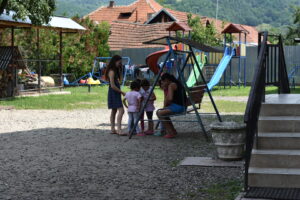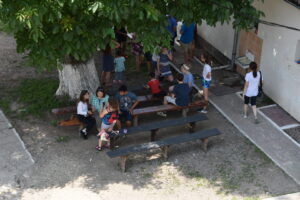United States and Romanian “othering”
A society cannot have a community without individuals. Though, with the concept of self, there remains problematic tendencies to “other” others. Perhaps, othering is historical—ingrained into the systems years ago. For my home community of Mt. Lebanon, our “othering” was evident with the predominantly White population living among very few people of color. Take, for example, a smaller representation of the larger community with the high school. Students could count how many people of color attended school on their hands. While this “othering”may not be intentional at first, the deep-rooted historical discrepancies are not taught in school and by contrast not challenged by community members, school board members, or students.
Historically, my community has participated in desegregation acts through busing children into the school, though this caused an “othering” of people once it ended. In other words, segregation ensued. The growing “us versus them” sensation was felt by many, but never discussed, making people of color more individuals than a community themselves.
Members coined “the bubble” as most equal to what Mt. Lebanon had become—no one or rather defining who can and can’t be a member of the community entered and no one or rather the overwhelming White population left. It constructively was a power strip, allowing the White population to remain in power. As a member of this “bubble,” I too contributed as White American girl or never took action to curb the othering of certain marginalized communities. My last year of high school, our school hired a successful Black woman as a unit principal. There was jokingly chatter throughout the school year as to whether she was hired purely because of the color of her skin. This type of questioning exemplifies how beyond just being a human being, the community still questioned hiring her as this momentous act with words of disbelief. While I lack the perspective to know what it feels like to be othered, I question how isolating it may be or how damaging the type of language that accepts the color of one’s skin as their only contributor to the conversation at the table.
The few moments when I exited the “bubble,” where to deliver groceries to more marginalized communities that economically lacked the means to feed themselves. Contrastingly, the community 15 minutes from downtown Pittsburgh had a large Black population. To me, they were more of a community and I was more of an individual entering a different world. Differently, however, I didn’t feel or think I was othered in any way, making the clear “them” quality of Mt. Lebanon a systemic problem that continues to be ignored, or at least outwardly made aware.
 Beyond the “bubble,” my travels to Romania in 2018 and 2019, especially exposure to the international orphanage system has shown me that there is a difference between “othering” and being a foreigner in someone else’s country. I traveled to Romania and worked with children at a particular orphanage near Cluj-Napoca, Romania. The children aged from three years of age to 18, depending on what their futures entailed. Unlike mainstream beliefs, the 18 year olds were not kicked out of the orphanage as soon as becoming adults. Instead, they could attend college with financial help from the orphanage or remain working with the orphanage in an effort to keep them out of their community’s particular dangers. While there, I recognized the obvious language barrier between an American and Romanian child, but how it does not make me an “other” because by definition, an “other” is someone who is considered not a member of the community or rather someone deemed less human than others by strange, racist, and unfair criteria.
Beyond the “bubble,” my travels to Romania in 2018 and 2019, especially exposure to the international orphanage system has shown me that there is a difference between “othering” and being a foreigner in someone else’s country. I traveled to Romania and worked with children at a particular orphanage near Cluj-Napoca, Romania. The children aged from three years of age to 18, depending on what their futures entailed. Unlike mainstream beliefs, the 18 year olds were not kicked out of the orphanage as soon as becoming adults. Instead, they could attend college with financial help from the orphanage or remain working with the orphanage in an effort to keep them out of their community’s particular dangers. While there, I recognized the obvious language barrier between an American and Romanian child, but how it does not make me an “other” because by definition, an “other” is someone who is considered not a member of the community or rather someone deemed less human than others by strange, racist, and unfair criteria.
 By nature, the concept of “othering” deals with power and the proportions that certain people have over others. Both learning and interacting with a different system other than the United States’ made me realize that orphan Romanian children are “others” in their own country. They had no control over where they were put before the orphanage helped them. While discussing with the directors of this orphanage, we learned that the system like many others is terribly structured, impacting the children’s’ well-being. Inherent to their mission statements, this orphanage wanted to escape the typical system’s issues and create as much as a welcoming and non-othering community for these kids as possible.
By nature, the concept of “othering” deals with power and the proportions that certain people have over others. Both learning and interacting with a different system other than the United States’ made me realize that orphan Romanian children are “others” in their own country. They had no control over where they were put before the orphanage helped them. While discussing with the directors of this orphanage, we learned that the system like many others is terribly structured, impacting the children’s’ well-being. Inherent to their mission statements, this orphanage wanted to escape the typical system’s issues and create as much as a welcoming and non-othering community for these kids as possible.